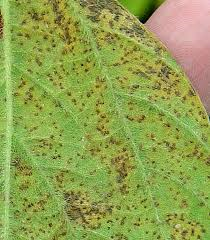Asian soybean rust (Phakopsora pachyrizi) was found this week in Madison and Jackson Counties on kudzu and soybean. Soybean rust is more widespread in Florida this year than in previous years despite the recent high temperatures and dry conditions. Typically soybean rust thrives in humid conditions.
The first symptoms of soybean rust begin as very small brown or red spots on the leaves of soybean plants. These spots usually appear in the lower canopy during or after flowering; seedlings can be infected as well. Often the first lesions appear toward the base of the leaflet near the petiole and leaf veins. This part of the leaflet retains dew and moisture longer, making conditions more favorable for infection. Lesions generally remain small (2-5 mm in diameter), but increase in number as the disease progresses. The key diagnostic features of soybean rust are the cone-shaped pustules that form mostly on the undersides of the leaves and the dusty, light-tannish colored spores that erupt from the pustules.
It is advised that all soybean producers plan to actively manage soybean rust in order to prevent low crop yields. Control options include applications of strobilurins (pyraclostrobin, azoxystrobin, trifloxystrobin), triazoles (tebuconazole, propiconazole), and tank mixes of strobilurins and triazole compounds. Yield increases of 20 bu/A have been noted with fungicides as compared to non-treated plots.
The website for Asian soybean rust and current updates on its spread can be found at http://sbrusa.net.
Source: UF/IFAS Extension: Soybean Rust found in Jackson County Sentinel Plot

